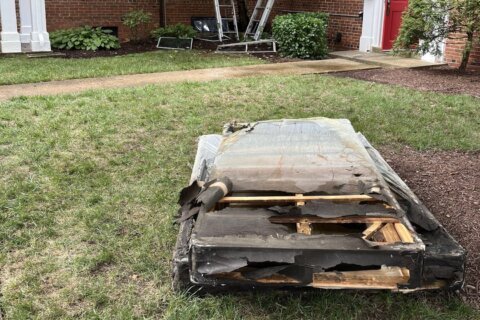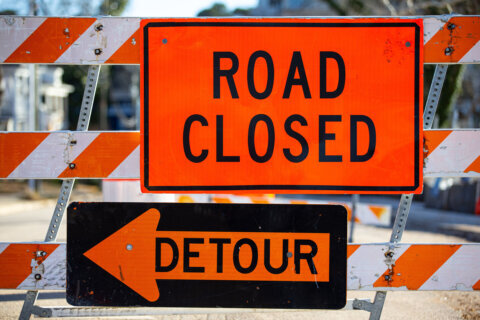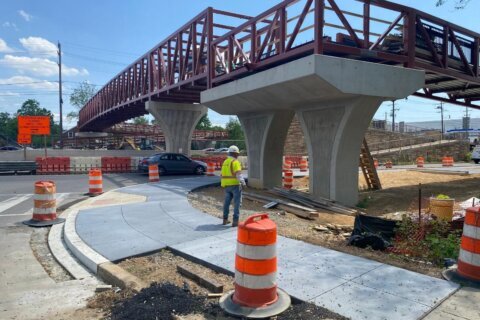Any new construction or renovation in D.C.’s Chinatown has to contribute to the area’s Chinese identity. But the small number of longtime residents and the former residents of the area, many of Chinese descent, may recognize little of the neighborhood where they were born and grew up.
Brothers Harry Guey-Lee and Jack Lee were born in D.C. and lived in Chinatown, and they said aside from the street addresses, very little is the same.
That includes their parents’ house on 734 Sixth St. NW — which became the transportation egress into the loading dock of what was then the MCI Center in 1996 — as well as the homes of their friends, where they used to hang out when they were young.
‘If you don’t have housing, you don’t have a community’
Even after the brothers moved to Maryland as adults, they would often run into people they knew when they came back to Chinatown. But most of the families have now moved away, and many who remain and still have property are just waiting to move out.
Harry Guey-Lee said many of the people he knows have been approached several times, and would be willing to sell for the right price.
Residents of Chinatowns nationwide face similar economic pressures, Harry Guey-Lee said, but in D.C., there’s no “critical mass” or “champion” to ensure that a semblance of Chinatown still exists. Moreover, money is necessary “because I know almost all the owners that still may have a partial row house building, all of them are selling for money,” Harry Guey-Lee said. “If you don’t have housing, you don’t have a community. And we lack all of that to make it a future.”
Jack Lee said he doesn’t see much of a community left in Chinatown, and he feels the area is already superficial. “You have to have that artificial language or linguistics or whatever you call it … caricatures.”
D.C.’s Chinatown Design Guide encourages designs that illustrate the “visual characteristics that make Chinatown unique and authentic.”
Examples of Chinese identity in the design guide include, to name a few, Chinese signage next to a business’ name, pavers that have the animals of the Chinese zodiac, and the streetlight design. Some elements are more subtle, such as how a roof might evoke the idea of a pagoda, a Chinese-inspired lamp at the entrance of a restaurant, or a prosperity symbol embedded in the stonework of a building.
Ted Gong is the executive director of the 1882 Foundation, which takes its name from the 1882 Chinese Exclusion Act, the first significant law restricting immigration into the United States, and the only law where a specific ethnic or national group was ever named specifically for exclusion.
He said the design elements are important. “You do need to have some ways to put markers that this place belongs to Chinatown. Whether it’s superficial or not, it’s still an effort to try to maintain things,” he said.
Ben de Guzman, the director of the Mayor’s Office on Asian and Pacific Islander Affairs, said Chinatown is the “legacy, heart of the AAPI community,” partly due to the predominantly Chinese senior citizens who live at Wah Luck House and have been in Chinatown for years.
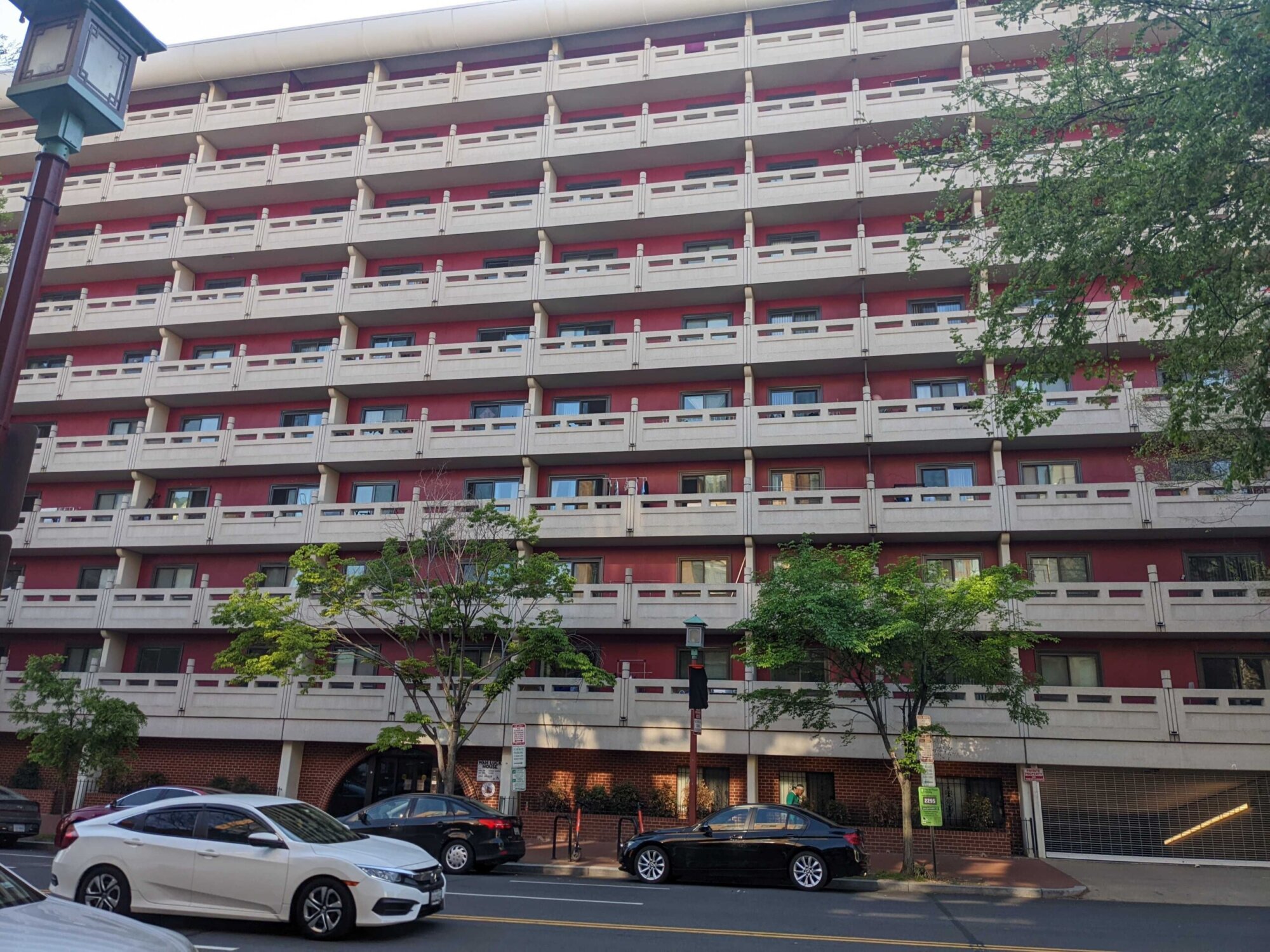
One of the remaining affordable housing communities, the 153-unit building on Sixth and H streets opened in 1982, and at the time, was intended to house members of the Chinese community displaced by construction of the convention center, The Washington Post reported.
De Guzman said Wah Luck House is one example of how affordable housing can really work to “integrate the community with the vibrancy of newly emerging businesses and neighborhoods,” and of how Capital One Arena can coexist with the seniors who are just up the street.
Wah Luck House Preservation LLC bought the building in 2017 for $55 million, and as part of the deal, the mostly elderly Chinese residents get to stay; they continue to pay affordable rents; and the building will be renovated, Washington City Paper reported.
De Guzman admits that it has been a challenge to maintain the unique identity of Chinatown, and that despite the Asian American and Pacific Islander flight to the suburbs, some do come back to visit relatives who still live there, or eat at a restaurant they’ve been going to since they were kids.
“But we’ve also tried to think about how some of the new partners, the new things in the District or in the area, can form new partnerships with us,” de Guzman said, citing an example a couple of years ago when a community event was held at the Xfinity store.
Gong has a similar suggestion of using the perimeter spaces of businesses, such as the display windows of the drugstore or the bank, for stories and exhibits showcasing Chinatown in order “to keep them alive.”
And Capital One Arena, which Gong said wields a “heavy influence in the area,” can help preserve Chinatown’s history by influencing the city to widen the streets and keep them cleaner, he said. “Be conscientious of the fact that there is a Chinese sensitivity … You have to have a sense of the space being sacred to the community,” Gong said.
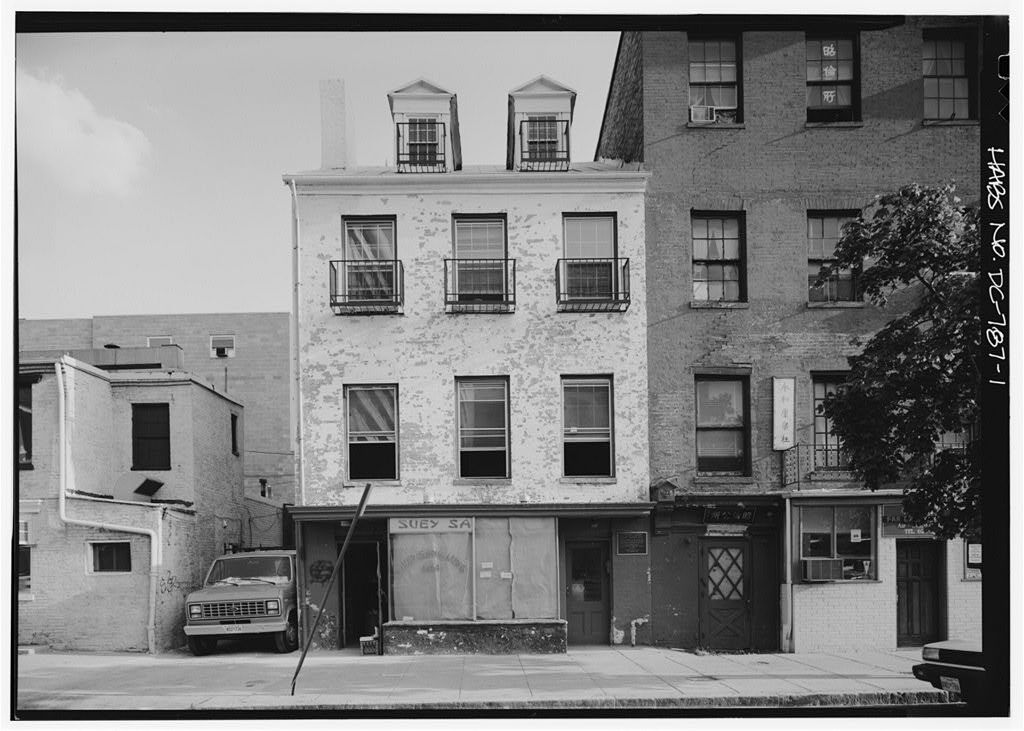
‘There’s no place for people to come park’
Gong said he thinks that the character of Chinatown is determined by the banquet business, at restaurants such as Tony Cheng’s on H Street. There used to be a lot of these restaurants, where people would come to celebrate a wedding, remember the death of a loved one or welcome the birth of a child; these are the types of places that Gong said maintains the culture.
“That’s when you exchange stories to reinforce your family ties. So when you lose the banquet business, that’s the problem, right?”
Banquet businesses are being pushed out by “liquor sales types of places” or fast-food joints, which appeal to customers attending sports events and young people seeking the bar scene instead of family restaurants, Gong said.
There’s another problem keeping former residents away not just from the banquet business, but from Chinatown in general, Gong said: “There’s no place for people to come park.”
Part of Mayor Muriel Bowser’s $17.5 billion 2022 budget included money for car-free lanes and improvements to buses. And since 2020, there have been car-free lanes in parts of Chinatown.
“The worst thing about D.C. is parking,” Jack Lee said, recalling the parking lots and street alleys where he and his friends used to play as kids. “Especially on a non-Sunday, you’re always worried about parking, getting a ticket and watching everything,” Jack Lee said.
That means multigenerational gatherings with extended family and old friends are instead happening in places such as Rockville, Maryland, where many Chinese and other people of Asian descent have moved, followed by the large Asian grocery stores, dim sum restaurants and bubble tea joints. Some are calling it the new Chinatown, Harry Guey-Lee said.
The brothers said they don’t believe D.C.’s Chinatown really exists, other than a few signs and a scattering of restaurants. And aside from special occasions that are ingrained in their roots, such as the Chinese New Year Parade, “We probably will not go downtown. We don’t have that attachment because the physical piece is gone,” Harry Guey-Lee said.
- Beyond Chinatown: Researching Asian American and Pacific Islander spaces in DC
- How to celebrate Asian American and Pacific Islander Heritage Month in the DC area
- Balikbayan boxes: How Spam, toothpaste, even toilet paper can say ‘I’m thinking about you’
- DC launches ‘Hate Stops with Us’ campaign to mark AAPI Heritage Month
Gong said it does not matter whether people live in Chinatown, as long as they come back to gather and reinforce the culture and traditions. “When you don’t have that, then that’s when Chinatown begins to die.”
Sojin Kim is a senior consultant on a project documenting and evaluating D.C. sites for their importance and significance in the story of Asian Americans in D.C. A historic preservation expert, she said you don’t want things to be frozen just for the sake of freezing it because something happened there.
“When people no longer feel connected to the history, or when there are no longer people who feel connected to that history, when there are no longer people who live in the neighborhood, who are themselves Chinese American and practicing whatever ties to heritage they might have, yes, the neighborhood identity might change. Or people might have moved away to be nearer to friends; or because they’re retired, and they no longer want to run the business. That’s just sort of natural, right? That’s just the natural life changes,” Kim said.
What concerns her, though, is if people have to leave or they’re forced to leave because they can’t pay their rent or afford to run their business when properties are bought and turned into spaces that charge high prices.
“That’s when it’s not a good kind of change … What worries me is when there’s a kind of coercion … that essentially pushes people out against their will,” Kim said, adding that there’s been a history of plans to revitalize downtown that has had an impact on the physical landscape where people lived and worked.
Chinatown as a cultural destination
Gong, with the 1882 Foundation, said that D.C.’s “sense of Chinatown” is ever-present in its economic development and small area plans, which aim to preserve it as a unique cultural destination. He sees it as a recognition of the need to maintain the culture, but also a balancing act between the need to keep it for Chinese people to remember and appreciate their traditions, and to make it an economic draw for tourists.
So how do you preserve Chinatown?
It’s not necessarily the buildings, Gong said, although it’s buildings that mark the place and give Chinese Americans a space to assemble. Rather, it’s preserving the oral histories, he said.
One of the foundation’s visions includes a National Chinatown Story Center in a space where Asian American and Pacific Islander nonprofits can do work producing cultural and heritage events. It’s part of a larger concept the foundation hopes will revive Chinatown and create a Downtown Cultural Zone.
But what happens when the last longtime Chinese residents are gone, properties have been sold, or the community associations have dwindled?
“Does that invalidate the fact that this place is important to us?” Gong said. He said he believes that people will come back for Chinese culture to “a sacred place that becomes a cultural touchstone” that can’t be replicated anywhere else.
Other communities outside D.C. make the effort to showcase Chinese culture — with events that include lion dancing, ribbon dancing and paper cutting — and do it, for example, at a mall. But “as soon as the thing is over, it converts back to a mall. There’s no sense of it being a place where it belongs to (the) Chinese,” Gong said.
In Northern Virginia, Eden Center, in Falls Church, has been a gathering place for the Vietnamese community and Annandale for the Korean community.
“I wish we had a nice little enclave like Eden Center with the Vietnamese people. All in Falls Church, 50 stores together, restaurants, parking, place to congregate to meet and have fun,” Harry Guey-Lee said.
He laments the lack of a central point, which Chinese from all over the area can call their “clubhouse.” Instead they meet at a friend’s home or a restaurant, or they play volleyball in Rockville at the Montgomery College parking lot. “Those are our meeting places” now, Harry Guey-Lee said.
His brother Jack Lee said that if one were to designate a place of significance, it would be where the parking lots used to be and the back alleys — the spots where they used to play.
“Everything was in the streets and in the alleys,” Jack Lee said. “I think that’s the thing I miss the most, being able to walk out, say, ‘I’ll meet you here at the steps,’ and we’re hanging out for a while.”


